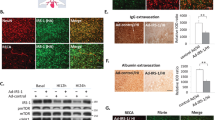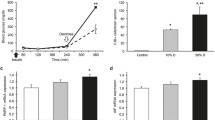Abstract
This study determined if dietary restriction (DR) protects against hypoxic-ischemia (HI) in the neonatal brain via insulin receptor substrate-1 (IRS-1)/Akt pathway-mediated downregulation of p53 in the neurovascular unit. On postnatal (P) day 7, HI was induced in rat pups grouped from P1 into normal litter size (NL, 12 pups/dam) and increased litter size (DR, 18 pups/dam). In vivo IRS-1 anti-sense oligonucleotide and IRS-1 overexpressed recombinant adenovirus were given, and neurovascular damage was assessed. In vitro models of oxygen-glucose deprivation (OGD) examined the inhibition and overexpression of IRS-1 on p53 and cell death in neurons and endothelial cells. Compared to NL pups, DR pups had significantly higher IRS-1, p-IRS-1, and pAkt levels, decreased p53, more tight junction proteins, reduced blood-brain barrier (BBB) damage after HI, and less infarct volumes at P21. Immunofluorescence revealed that IRS-1 was upregulated in the endothelial cells and neurons of DR pups. IRS-1 downregulation in DR pups reduced p-Akt, increased p53, worsened BBB damage, and increased brain injury, whereas IRS-1 overexpression in NL pups upregulated p-Akt, decreased p53, attenuated BBB damage, and decreased brain injury. In vitro, IRS-1 downregulation aggravated cell death in neurons and endothelial cells and is associated with decreased p-Akt and increased p53. In contrast, IRS-1 overexpression reduced cell death in endothelial cells with increased p-Akt and decreased p53. In conclusion, DR reduces neurovascular damage after HI in the neonatal brain through an IRS-1/Akt-mediated p53 downregulation, suggesting that IRS-1 signaling is a therapeutic target for hypoxic brain injury in neonates.








Similar content being viewed by others
References
Hawkins BT, Davis TP (2005) The blood-brain barrier/neurovascular unit in health and disease. Pharmacol Rev 57:173–185
Arai K, Jin G, Navaratna D, Lo EH (2009) Brain angiogenesis in developmental and pathological processes: neurovascular injury and angiogenic recovery after stroke. FEBS J 276:4644–4652
Kennedy BK, Steffen KK, Kaeberlein M (2007) Ruminations on dietary restriction and aging. Cell Mol Life Sci 64:1323–1328
Tu YF, Lu PJ, Huang CC, Ho CJ, Chou YP (2012) Moderate dietary restriction reduces p53-mediated neurovascular damage and microglia activation after hypoxic ischemia in neonatal brain. Stroke 43:491–498
Sharma N, Castorena CM, Cartee GD (2012) Tissue-specific responses of IGF-1/insulin and mTOR signaling in calorie restricted rats. PLoS One 7, e38835
Gual P, Le Marcharnd-Brustel Y, Tanti JF (2005) Positive and negative regulation of insulin signaling through IRS-1 phosphorylation. Biochimie 87:99–109
Cantley LC (2002) The phosphoinositide 3-kinase pathway. Science 296:1655–1657
Stempien-Otero A, Karsan A, Cornejo CJ, Xiang H, Eunson T, Morrison RS et al (1999) Mechanisms of hypoxia-induced endothelial cell death. Role of p53 in apoptosis. J Biol Chem 274:8039–8045
Berkers CR, Maddocks ODK, Cheung EC, Mor I, Vousden KH (2013) Metabolic regulation by p53 family members. Cell Metab 18:617–633
Tu YF, Tsai YS, Wang LW, Wu HC, Huang CC, Ho CJ (2011) Overweight worsens apoptosis, neuro-inflammation and blood-brain barrier damage after hypoxic ischemia in neonatal brain through JNK hyper-activation. J Neuroinflammation 8:40
Han BH, Holtzman DM (2000) BDNF protects the neonatal brain from hypoxic-ischemic injury in vivo via the ERK pathway. J Neurosci 20:5775–5781
Paxinos G, Watson C (1986) The rat brain in stereotaxic coordinates, 2nd edn. Academic, San Diego
Swanson RA, Morton MT, Tsao-Wu G, Savalos RA, Davidson C, Sharp FR (1990) A semiautomated method for measuring brain infarct volume. J Cereb Blood Flow Metab 10:290–293
Svedin P, Hagberg H, Savman K, Zhu C, Mallard C (2007) Matrix metalloproteinase-9 gene knock-out protects the immature brain after cerebral hypoxia-ischemia. J Neurosci 27:1511–1518
Lee HT, Chang YC, Tu YF, Huang CC (2010) CREB activation mediates VEGF-A’s protection of neurons and cerebral vascular endothelial cells. J Neurochem 113:79–91
Gottlieb TM, Leal JF, Seger R, Taya Y, Oren M (2002) Cross-talk between Akt, p53 and Mdm2: possible implications for the regulation of apoptosis. Oncogene 21:1299–1303
Morrione A, Navarro M, Romano G, Dews M, Reiss K, Valentinis B et al (2001) The role of the insulin receptor substrate-1 in the differentiation of rat hippocampal neuronal cells. Oncogene 20:4842–4852
Jiang ZY, He Z, King BL, Kuroki T, Opland DM, Suzuma K et al (2003) Characterization of multiple signaling pathways of insulin in the regulation of vascular endothelial growth factor expression in vascular cells and angiogenesis. J Biol Chem 278:31964–31971
Kim JA, Montagnani M, Koh KK, Quon MJ (2006) Reciprocal relationships between insulin resistance and endothelial dysfunction: molecular and pathophysiological mechanisms. Circulation 113:1888–1904
Lin HY, Wu CL, Huang CC (2010) The Akt-endothelial nitric oxide synthase pathway in lipopolysaccharide preconditioning-induced hypoxic-ischemic tolerance in the neonatal rat brain. Stroke 41:1543–1551
Hsu YC, Chang YC, Lin YC, Sze CI, Huang CC, Ho CJ (2014) Cerebral microvascular damage occurs early after hypoxia-ischemia via nNOS activation in the neonatal brain. J Cereb Blood Flow Metab 34:668–676
Acknowledgments
This study was supported by grants from the Taiwan Ministry of Science and Technology (NSC100-2314-B-006-042-MY3, NSC101-2314-B-006-034-MY3, MOST 103-2314-B-006-017-MY3).
Conflicts of Interest
The authors declare that they have no competing interests.
Research Involving Animals
This study was approved by National Cheng Kung University’s Animal Care Committee
Informed Consent
Not indicated
Author information
Authors and Affiliations
Corresponding author
Electronic supplementary material
Below is the link to the electronic supplementary material.
Fig. 1S
A representative picture showed the dark stained 5′ biotinylated-oligonucleotide introcerebroventricularly delivered into the ipsilateral cortex, hippocampus and striatum. (GIF 209 kb)
Rights and permissions
About this article
Cite this article
Tu, YF., Jiang, ST., Chow, YH. et al. Insulin Receptor Substrate-1 Activation Mediated p53 Downregulation Protects Against Hypoxic-Ischemia in the Neonatal Brain. Mol Neurobiol 53, 3658–3669 (2016). https://doi.org/10.1007/s12035-015-9300-5
Received:
Accepted:
Published:
Issue Date:
DOI: https://doi.org/10.1007/s12035-015-9300-5




